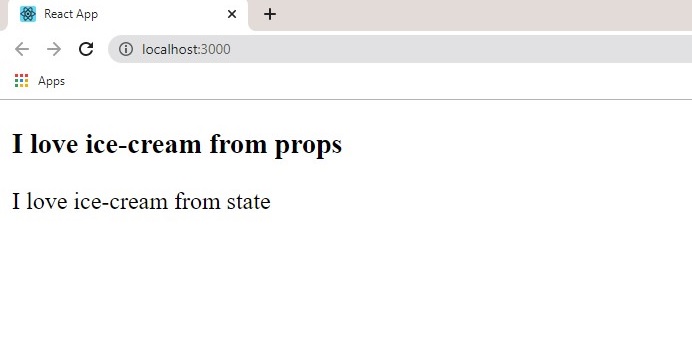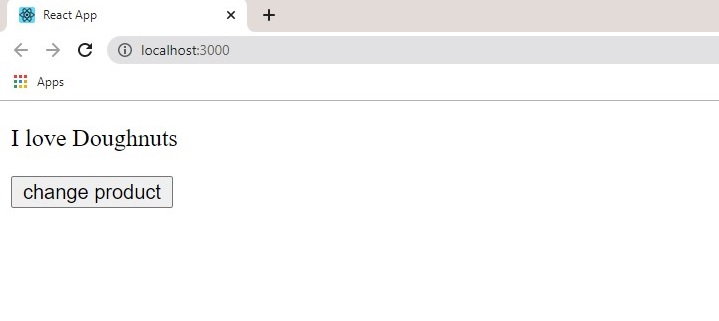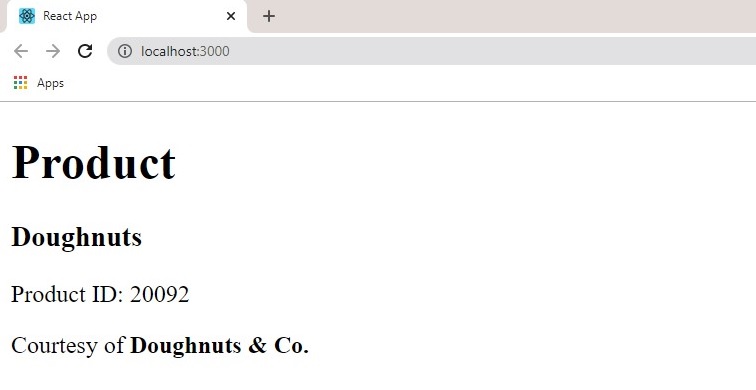React State
The state is a region or store where all the data we want comes from. The state of any given component should be as minimal as possible. A state is a JavaScript object containing data we would like to use in our app. In our earlier example of an e-commerce website, the state of our products should be present in the <Body/> component and can then be passed down as props to its children's component.
Usage of State
A state can be created with a class component like below, a class function has a built-in state object:
Product.js:
import React from 'react'
export default class Product extends React.Component {
constructor(props) {
super(props);
this.state = {
product: "ice-cream",
};
}
render() {
return (
<div>
<h3> I love {this.props.product} from props </h3>
<p> I love {this.state.product} from state</p>
</div>
);
}
}
Result:

State originally belonged only to the class-based components, giving functional components the name ‘stateless components’ but that became false when Hooks were introduced in 2019.
The state of a class component can be changed only by using the function this.setState(). For example,
import React from 'react'
export default class Product extends React.Component {
constructor() {
super()
this.state = {
product: 'ice-cream'
}
}
changeProduct = () => {
this.setState({
product: 'Doughnuts'
})
}
render() {
return (
<div>
<p> I love {this.state.product}</p>
<button onClick={this.changeProduct}>change product</button>
</div>
)
}
}
Result:

This can be explained thus:
The original state contained data ‘product’ with value ‘ice-cream’, when the button is clicked, the event ‘onClick’ is triggered and a function changeProduct() is activated that changes the state object’s product value to ‘Doughnut’. Open the browser’s console and navigate to the root <div>, then check the <p> element. Click the button, notice that only ‘ice-cream’ is changed without the whole page re-rendering. That is the power of React virtual DOM.
Putting it together
Let’s create an example where we initialize a state in a Products component and render their value to the browser.
Products.js:
import React, { Component } from 'react'
export default class Products extends Component {
state = {
productName: 'Doughnuts',
id: 20092,
company: 'Doughnuts & Co.'
}
render() {
return (
<div>
<></>
</div>
)
}
}
In Products.js, we initialized a state containing a product name, id, and the company. We now desire to render their values to the screen:
Products.js:
import React, { Component } from 'react'
export default class Products extends Component {
state = {
productName: 'Doughnuts',
id: 20092,
company: 'Doughnuts & Co.'
}
render() {
return (
<div>
<h1>Product</h1>
<h3>{this.state.productName}</h3>
<p>Product ID: {this.state.id}</p>
<p>Courtesy of <strong>{this.state.company}</strong> </p>
</div>
)
}
}
We refer to the state by using the ‘this’ keyword to indicate the current class followed by the property name, this.state.propertyName.
Result:

React gives us the opportunity to think more, so as to write less.

